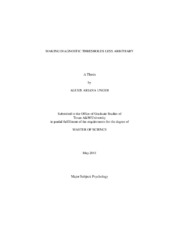| dc.contributor.advisor | Balsis, Steve | |
| dc.creator | Unger, Alexis Ariana | |
| dc.date.accessioned | 2012-07-16T15:56:36Z | |
| dc.date.accessioned | 2012-07-16T20:20:58Z | |
| dc.date.available | 2012-07-16T15:56:36Z | |
| dc.date.available | 2012-07-16T20:20:58Z | |
| dc.date.created | 2011-05 | |
| dc.date.issued | 2012-07-16 | |
| dc.date.submitted | May 2011 | |
| dc.identifier.uri | https://hdl.handle.net/1969.1/ETD-TAMU-2011-05-9145 | |
| dc.description.abstract | The application of diagnostic thresholds plays an important role in the classification of mental disorders. Despite their importance, many diagnostic thresholds are set arbitrarily, without much empirical support. This paper seeks to introduce and analyze a new empirically based way of setting diagnostic thresholds for a category of mental disorders that has historically had arbitrary thresholds, the personality disorders (PDs). I analyzed data from over 2,000 participants that were part of the Methods to Improve Diagnostic Assessment and Services (MIDAS) database. Results revealed that functional outcome scores, as measured by Global Assessment of Functioning (GAF) scores, could be used to identify diagnostic thresholds and that the optimal thresholds varied somewhat by personality disorder (PD) along the spectrum of latent severity. Using the Item response theory (IRT)-based approach, the optimal threshold along the spectrum of latent severity for the different PDs ranged from θ = 1.50 to 2.25. Effect sizes using the IRT-based approach ranged from .34 to 1.55. These findings suggest that linking diagnostic thresholds to functional outcomes and thereby making them less arbitrary is an achievable goal. This study has introduced a new and uncomplicated way to empirically set diagnostic thresholds while also taking into consideration that items within diagnostic sets may function differently. Although purely an initial demonstration meant only to serve as an example, by using this approach, there exists the potential that diagnostic thresholds for all disorders could one day be set on an empirical basis. | en |
| dc.format.mimetype | application/pdf | |
| dc.language.iso | en_US | |
| dc.subject | diagnostic threshold | en |
| dc.subject | item response theory (IRT) | en |
| dc.subject | personality disorder (PD) | en |
| dc.subject | global assessment of functioning (GAF) | en |
| dc.title | Making Diagnostic Thresholds Less Arbitrary | en |
| dc.type | Thesis | en |
| thesis.degree.department | Psychology | en |
| thesis.degree.discipline | Psychology | en |
| thesis.degree.grantor | Texas A&M University | en |
| thesis.degree.name | Master of Science | en |
| thesis.degree.level | Masters | en |
| dc.contributor.committeeMember | Taylor, Aaron | |
| dc.contributor.committeeMember | Peterson, Rick | |
| dc.type.genre | thesis | en |
| dc.type.material | text | en |


